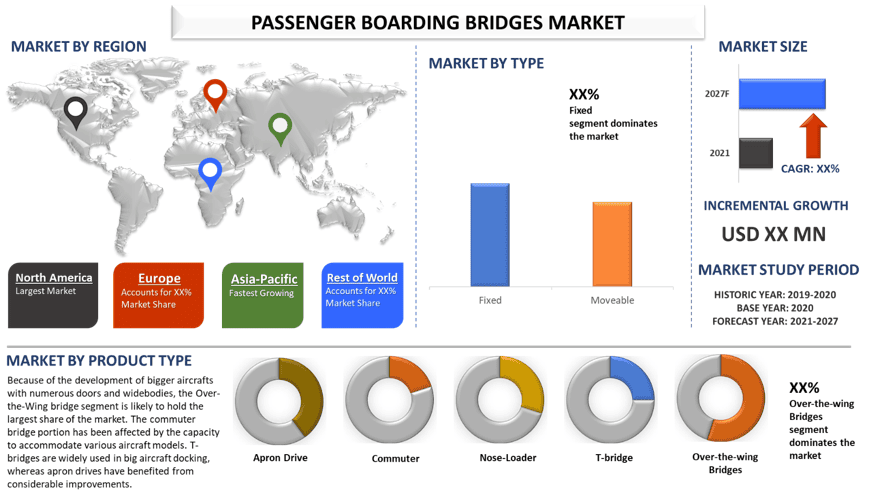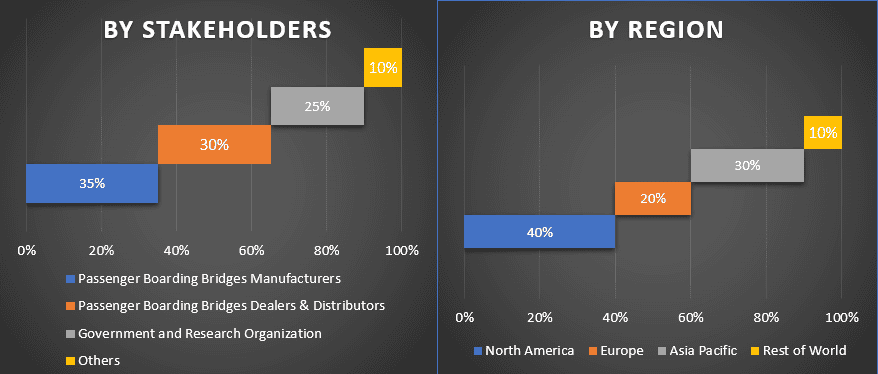- Home
- About Us
- Industry
- Services
- Reading
- Contact Us
Passenger Boarding Bridges Market: Current Analysis and Forecast (2021-2027)
Emphasis on Elevation System (Hydraulic and Electro-mechanical System); Type (Fixed and Moveable); Product Type (Apron Drive, Commute, Nose-Loader, T-bridge and Over-the-wing Bridges); Structure (Glass Walled and Steel Walled); Region and Country

Global Passenger Boarding Bridges is anticipated display a CAGR of around ~10% over the forecast period (2021-2027). Over the last few years, aviation passenger traffic has been significantly expanding over the world. This rise has been impacted by factors such as lower airfares, rising per capita disposable incomes, especially in emerging nations, and improving living standards. Global aviation traffic is expected to quadruple by 2036, according to the International Air Transport Association (IATA). The need for new airplanes has increased in response to the expanding number of passengers. During the study period, this is also likely to fuel the expansion of the passenger boarding bridges market. Increased passenger numbers, rehabilitation and upgrade of ageing facilities, expansion of current terminals, and the construction of new airports are all driving worldwide passenger boarding demand. Airport authorities are under pressure to create upgraded infrastructure, particularly sophisticated passenger boarding bridges, due to rising passenger volume and the aircraft’s short turnaround time. Along with the rapidly developing aviation business, heightened worries about airport security, the implementation of e-passports, and the requirement for additional aircraft ground support infrastructure have directed investment efforts while paving the path for enhanced infrastructure expansion.
Insights Presented in the Report
“Amongst Elevation System, Hydraulic segment dominated the market in 2020”
Based on elevation system, the market is segmented into Hydraulic and Electro-mechanical System. The Hydraulic segment is expected to grow at a higher CAGR during the forecasted period. The Electro-mechanical system is expected to record the highest growth rate during the forecast period from 2020 and 2026. This is due to the increasing demand for energy-efficient and clean passenger boarding bridges by the airport authorities globally. Whereas the Hydraulic segment holds the largest share due to its wider use of hydraulic passenger boarding bridges at the number of airports.
“Amongst Type, Fixed segment dominated the market in 2020.”
Based on type, the market is segmented into Fixed and Moveable. The Fixed segment is expected to grow at a higher CAGR during the forecasted period. The majority of the regional airports adopt the fixed bridges whereas the airports with the requirement of adjustable heights refer the movable bridge.
“Amongst Product Type, Over-the-wing Bridges segment dominated the market in 2020.”
Based on product type, the market is segmented into Apron Drive, Commuter, Nose-Loader, T-bridge and Over-the-wing Bridges. The Over-the-wing Bridges segment is expected to grow at a higher CAGR during the forecasted period. Because of the development of bigger aircrafts with numerous doors and widebodies, the Over-the-Wing bridge segment is likely to hold the largest share of the market. The commuter bridge portion has been affected by the capacity to accommodate various aircraft models. T-bridges are widely used in big aircraft docking, whereas apron drives have benefited from considerable improvements. Nose-loader bridges are typically utilized in airports that experience severe weather.
“Amongst Structure, Glass Walled segment dominated the market in 2020.”
Based on structure, the market is segmented into Glass Walled and Steel Walled. The Glass Walled segment is expected to grow at a higher CAGR during the forecasted period. With the growing trend of offering passengers with a more luxurious experience, demand for glass-walled passenger boarding bridges is on the rise. The visual appeal of glass-walled jet bridges, as well as the fact that they make boarding an aircraft less glass restricting, is driving their global adoption.
“North America represents as the largest market.”
Based on the estimation, during the projection period of 2021-2027, North America dominates the market whereas Asia Pacific market is predicted to be the fastest-growing region in the coming years. The rapid expansion of the commercial aviation sector in Asia Pacific has positioned the area as one of the world’s fastest growing. The continued acquisition of new aircraft, as well as the development of many new airports, are driving expenditures in airport infrastructure, creating enormous prospects for market expansion during the projection period. The continuous rising demand for passenger boarding bridges from countries such as Japan, China, Taiwan, Indonesia, South Korea, Australia, and India is adding to the growth of the market. Asia Pacific records the highest number of total passengers carried on scheduled services by registered airlines as 780.7 million passengers. Some of the major players operating in the market includes Thyssen Krupp AG, JBT Corporation, ShinMaywa Industries, Mitsubishi Heavy Industries Ltd., FMT Sweden AB, CIMC, Adelte Group, UBS Airport Systems, Hubner GMBH & CO KG, PT Bukaka Teknik Utama TBK etc.
Reasons to buy this report:
- The study includes market sizing and forecasting analysis validated by authenticated key industry experts
- The report presents a quick review of overall industry performance at one glance
- The report covers an in-depth analysis of prominent industry peers with a primary focus on key business financials, product portfolio, expansion strategies, and recent developments
- Detailed examination of drivers, restraints, key trends, and opportunities prevailing in the industry
- The study comprehensively covers the market across different segments
- Deep dive regional & country-level analysis of the industry
Customization Options:
The Global Passenger Boarding Bridges Market can further be customized as per the requirement or any other market segment. Besides this, UMI understands that you may have your own business needs, hence feel free to connect with us to get a report that completely suits your requirements.
Table of Content
The worldwide passenger boarding bridge market is being driven by an increase in demand for bigger aircraft and a growing number of greenfield and brownfield airport developments. In addition, the market’s development has been affected by airport operators’ increased spending in airside infrastructure. The need for bigger aircraft has grown as the number of passengers has increased. As a result, several airlines are purchasing bigger planes to accommodate more passengers on a single flight. As the passenger boarding bridge market has grown, there has been a greater desire to accommodate more people per gate every flight. The passenger boarding bridge makes it easier to board bigger planes in a more efficient and convenient manner. Because of the strong demand for big aircraft has also driven the passenger boarding bridge market.
Seek More Details About Research Methodology
Due to rising passenger traffic, a large increase in demand for new aircraft, and severe aviation rules linked to safety, the global passenger boarding bridges market has seen rapid expansion in recent years. Furthermore, the rising development of greenfield and brownfield airports are some of the factors propelling the market forward. The high durability of passenger boarding bridges, on the other hand, is projected to limit market expansion. Aerobridge is another name for a passenger boarding bridge (PBB). It’s a hanging, moveable tunnel that connects an airport to an aircraft. Passengers can board quickly and easily as a result of this. This aerobridge allows passengers to securely go from the airport terminal to the aircraft while also sheltering them from the elements. By restricting access to aprons and operational areas, it also increases security. The passenger boarding bridge’s major goal is to make it as easy as possible for passengers to get from the airport terminal to the aircraft and return. Passenger boarding bridges used to be made out of a permanent platform with no height adjustments that was enclosed and connected to the terminal building. Modern approaches, such as movable units, are being employed to move the aerobridge from one terminal end to the other more quickly. These units may be adjusted in height and can be utilized by a variety of aircraft.
Analysis of Historical Market Size
Step 1: In-Depth Study of Secondary Sources:
Detailed secondary study was conducted to obtain the historical market size of the Passenger Boarding Bridges through company internal sources such as annual report & financial statements, performance presentations, press releases, etc., and external sources including journals, news & articles, government publications, competitor publications, sector reports, third-party database, and other credible publications.
Step 2: Market Segmentation:
After obtaining the historical market size of the Passenger Boarding Bridges, we conducted a detailed secondary analysis to gather historical market insights and share for different segments & sub-segments for major regions. Major segments included in the report are by elevation system, type, product type, structure. Further regional & country-level analyses were conducted to evaluate the overall adoption of the Passenger Boarding Bridges in the global context.
Step 3: Factor Analysis:
After acquiring the historical market size of different segments and sub-segments, we conducted a detailed factor analysis to estimate the current market size. Further, we conducted factor analysis using dependent and independent variables such as growing government incentives and demand for eco-friendly transportations etc. Historical trends and their year-on-year impact on the market size and share was analyzed. Demand and supply side scenario was also thoroughly studied.
Current Market Size Estimate & Forecast
Current Market Sizing: Based on actionable insights from the above 3 steps, we arrived at the current market size, key players in the Market, and market shares of the segments and company. All the required percentage split, and market breakdowns were determined using the above-mentioned secondary approach and were verified through primary interviews.
Estimation & Forecasting: For market estimation and forecast, weights were assigned to different factors including drivers & trends, restraints, and opportunities available for the stakeholders. After analyzing these factors, relevant forecasting techniques i.e., bottom-up approach was applied to arrive at the market forecast to 2027 for different segments and subsegments across the major regions globally. The research methodology adopted to estimate the market size encompasses:
- The industry’s market size, in terms of value (US$) and the adoption rate of Passenger Boarding Bridges across the major markets
- All percentage shares, splits, and breakdowns of market segments and sub-segments
- Key players in the Passenger Boarding Bridges in terms of products offered. Also, the growth strategies adopted by these players to compete in the fast-growing market.
Market Size and Share Validation
Primary Research: In-depth interviews were conducted with the Key Opinion Leaders (KOLs) including Top Level Executives (CXO/VPs, Sales Head, Marketing Head, Operational Head, and Regional Head, Country Head, etc.) across major countries. Primary research findings were then summarized, and statistical analysis was performed to prove the stated hypothesis. Inputs from primary research were consolidated with secondary findings, hence turning information into actionable insights.
Split of Primary Participants in Different Regions

Market Engineering
Data triangulation technique was employed to complete the overall market estimation and to arrive at precise statistical numbers of each segment and sub-segment of the Passenger Boarding Bridges. Data was split into several segments & sub-segments post studying various parameters and trends in the areas of elevation system, type, product type, structure, and region.
The main objective of the Passenger Boarding Bridges Study
The current & future market trends of Passenger Boarding Bridges were pinpointed in the study. Investors can gain strategic insights to base their discretion for investments from the qualitative and quantitative analysis performed in the study. Current and future market trends would determine the overall attractiveness of the market at a regional & country level, providing a platform for the industrial participant to exploit the untapped market to benefit as a first-mover advantage. Other quantitative goals of the studies include:
- Analyze the current and forecast market size of Passenger Boarding Bridges in terms of value (US$). Also, analyze the current and forecast market size of different segments and sub-segments
- Segments in the study include sub-system and vehicle type
- Defined analysis of the regulatory framework for the Global Passenger Boarding Bridges industry
- Analyze the value chain involved with the presence of various intermediaries, along with analyzing customer and competitor behaviors of the industry
- Analyze the current and forecast market size of the Passenger Boarding Bridges for the major regions & countries
- Major regions studied in the report include North America (US, Canada, Rest of North America), Europe (Germany, United Kingdom, France, Italy, Spain, Rest of Europe), Asia Pacific (China, Japan, India, Australia, Rest of Asia-Pacific), and Rest of World
- Company profiles of the Passenger Boarding Bridges players and the growth strategies adopted by them to sustain in the fast-growing market
- Deep dive regional & country level analysis of the industry
Related Reports
Customers who bought this item also bought










